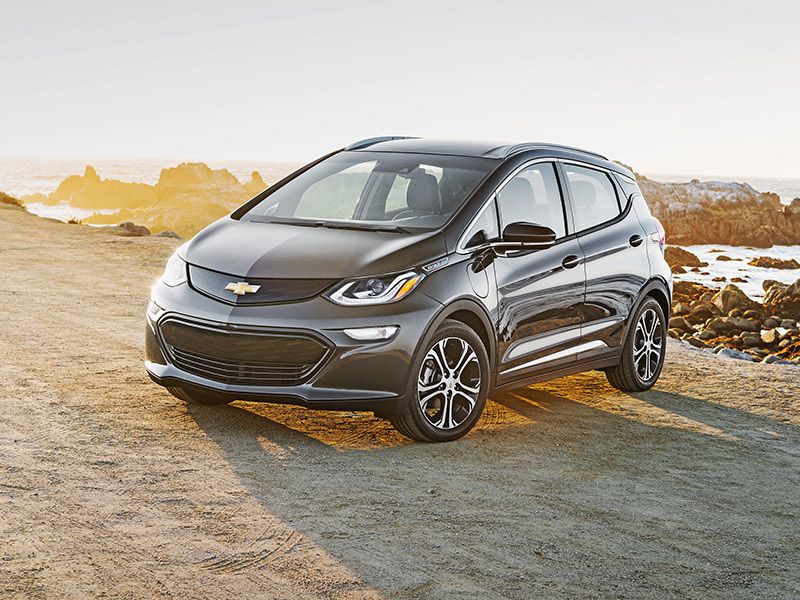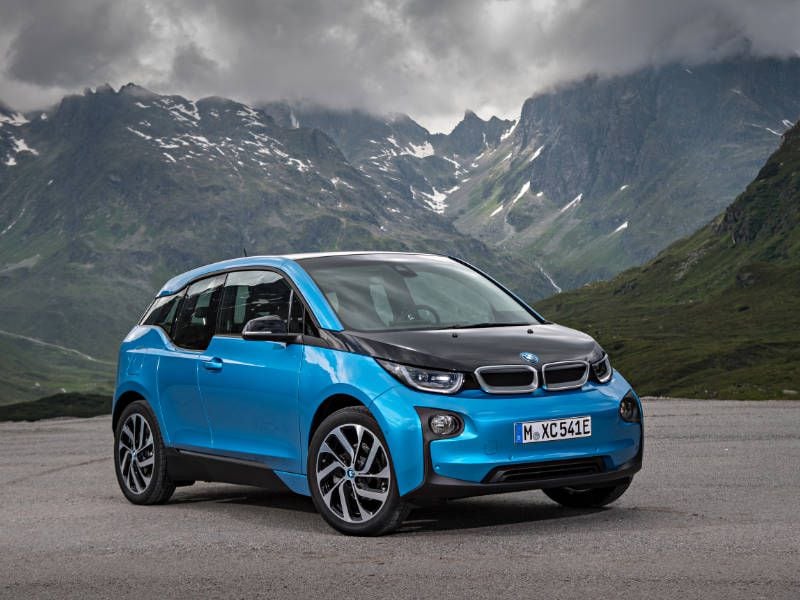Recent Articles
Popular Makes
Body Types
2018 Chevrolet Bolt vs. 2018 BMW i3: Which Is Best?

2018 BMW i3 vs 2018 Chevrolet Bolt exterior profile ・ Photo by BMW / General Motors
Two of the most popular battery electric vehicles on the market today are the BMW i3 and the Chevrolet Bolt. Each of these tall hatchbacks has appealing features, and each one qualifies for a $7,500 federal income tax credit, plus additional tax credits in certain states.
To determine which of the two EVs is best, we’ll compare the main features and statistics of both cars. Each one has its strong points, and you can make the final decision about which one suits your personal needs.
Electric Driving Range
Range anxiety is one of the biggest reasons consumers are uncertain about choosing electric vehicles. But the current generation of EVs has answered that concern with increased battery capacity and range-extending gasoline engines.
The i3 offers an all-electric driving range of 114 miles. However, the i3 can also be equipped with a range-extender gasoline engine that boosts its total range to 180 miles. Plus, you can refuel that engine at any gas station. Meanwhile, the Bolt has one of the highest ranges in the industry at 238 miles on a full charge. Only some Tesla models go farther. If you need up to 420 miles of range on a combination of electric and gasoline power, you can move up to the larger Chevrolet Volt plug-in hybrid.
Chevrolet Bolt

Photo by General Motors
Torque and Horsepower
One of the leading benefits of electric motors is that they deliver excellent torque at all RPM levels, which makes them quick to accelerate and fun to drive.
The i3 comes with 184 pound-feet of torque and 170 horsepower. That’s enough to propel the little BMW to 60 mph in just 7.2 seconds. Top speed on the i3 is governed at 93 mph. The Bolt is rated at an impressive 266 pound-feet of torque and 200 horsepower. With that much power on tap, the Bolt is capable of 0-60 acceleration in 6.5 seconds. The Bolt can achieve a top speed of 91 mph.
Chevrolet Bolt

Photo by General Motors
Charging Time
Another concern about EVs is the time required to recharge. With the latest in Direct Current (DC) fast charging, that time is coming down to the level of a mealtime. The Bolt goes from empty to full in about 9.5 hours with typical Level 2 240-volt charging, or about two hours with the optional DC fast charger capability. A full recharge on 120-volt wall outlet takes about 59.5 hours. The i3 can be fully charged from zero in 4.8 hours with a Level 2 charger, or up to 80% charge in about 40 minutes on DC fast charging. DC fast-charge capability comes standard on the BMW.
With charge times, it’s important to remember that the length of time to charge is based on the size of the battery pack, which also determines the range. Longer range generally means longer recharge times. Also note that very few owners will run their EVs down to zero, so your actual recharge times with a partially full battery pack will be substantially shorter than those listed here.

Photo by BMW
Combined MPGe
When you look at an electric car, you’ll see that the EPA assigned it an average miles per gallon equivalent (MPGe) figure. Of course, there are no gallons in a pure EV, but it refers to the distance it can travel using the amount of energy found in a gallon of gasoline.
The numbers are impressive for both the Bolt and the i3. The BMW receives a rating of 118 MPGe, while the Bolt gets 119 MPGe. What that tells you is that these two cars are more efficient than the Smart ForTwo Electric Drive and Kia Soul EV at 108 MPGe; the Nissan LEAF or Fiat 500e at 112 MPGe; or the Honda Clarity EV at 114 MPGe.
Chevrolet Bolt

Photo by Chevrolet
Interior Tech
When people buy a high-tech electric vehicle, they expect to find new technology in the cabin. The Bolt comes with a 10.2-inch touchscreen that supports both Android Auto and Apple CarPlay. Like all General Motors products, the Bolt has its own 4G/LTE data receiver and can generate a Wi-Fi signal inside the car. A Bose premium sound system is optionally available on the Premier trim.
The i3 comes with a 6.5-inch high-resolution screen controlled from BMW's iDrive dial interface on the center console. The system supports both HD radio and Sirius/XM. In-car music options include Bluetooth streaming and a USB port. An upgraded iDrive system with Apple CarPlay support is optional, as is a 16-speaker Harman Kardon sound system.
Chevrolet Bolt

Photo by General Motors
Safety
Part of what makes EVs so efficient is their generally smaller size. The BMW i3 and Chevrolet Bolt are among the smallest cars on the market, but that doesn’t mean you have to sacrifice safety.
The Bolt was the first EV to win a 2017 Top Safety Pick rating from the Insurance Institute for Highway Safety. However, IIHS did not like the Bolt’s high-intensity discharge (HID) headlights, explaining that they produced too much glare for oncoming drivers. The i3 was denied the Top Safety Pick designation because its seats and head restraints did not receive top ratings. All other aspects of the BMW did receive top safety scores, however.
Chevrolet Bolt

Photo by Chevrolet
One-Pedal Driving
One feature of electric cars that drivers come to enjoy is the ability to perform most normal driving using just one pedal. Because electric vehicles use deceleration to regenerate electricity for their batteries, drivers can set the cars to maximize regeneration and simply lift off the accelerator to stop.
Both the BMW and the Chevrolet offer one-pedal driving capability, and excellent regeneration. When the i3 was introduced in 2013, Green Car Reports said the i3 has "by far the best, and best modulated, regenerative braking we’ve driven." One feature to note on the Bolt is the Regen on Demand paddle, which uses regeneration to slow the car without touching the brake pedal. Pull the paddle for easy slowing maneuvers, and you’ll get some electricity back in the battery.
Tie

Photo by BMW
Cargo Space
The reason to buy an EV is to use the electric driveline instead of relying on fossil fuels. Most drivers can achieve substantial fuel savings by switching to an EV. But an electric vehicle is still a vehicle, and most people will want to carry some cargo from time to time. Both the Bolt and the i3 are small cars, so interior space can be limited, but each will hold a surprising volume of stuff if you need to do so.
The trunk of the i3 measures 15.1 cubic feet, where the Bolt offers 16.9 cubic feet. With the rear seat folded down, you can get 36.9 cubic feet of gear into the i3, or 56.6 cubic feet in the Bolt.
Chevrolet Bolt

Photo by General Motors
Cabin Design
A car's interior design is a personal preference, and there’s really no right or wrong answer. Both the Bolt and the i3 offer advanced, futuristic cabins that emphasize the next-generation nature of these cars. The Bolt has a sporty look that features man-made materials and a flowing, high-visibility window design. The shifter is a familiar setup, and both the infotainment display and the driver’s gauges are set into the dash. The Bolt is updated, but still traditional.
In contrast, the i3 has a more controversial interior design that is far from anything else BMW provides. The BMW's dashboard features broad swaths of open-grain wood, while both the infotainment screen and the driver information display are distinct from the dash and seem to float. The sparse i3 design has both been praised and criticized.
Tie

Photo by BMW
Retail Price and Verdict
The most basic BMW i3 carries a sticker price of $45,445, but that can rise if you pick the sportier i3s model, add option packages, or choose the range-extender engine. The most expensive i3s with range extender retails for $55,095. The Chevrolet Bolt starts at $37,495, but you could spend as much as $45,605 for the top Premier trim with all options selected. Both vehicles are eligible for a $7,500 Federal income tax credit, and 15 states offer some form of benefit, from tax rebates to HOV lane access or reduced fees. You can learn more about the tax credits here.
Choosing an EV is a personal decision, based on your taste and your requirements for range and utility. On the road, the Bolt delivers a quicker, sportier drive while the i3 is more sedate and futuristic. You’ll have to take test drives to see which experience is right for you.
Chevrolet Bolt

Photo by Chevrolet